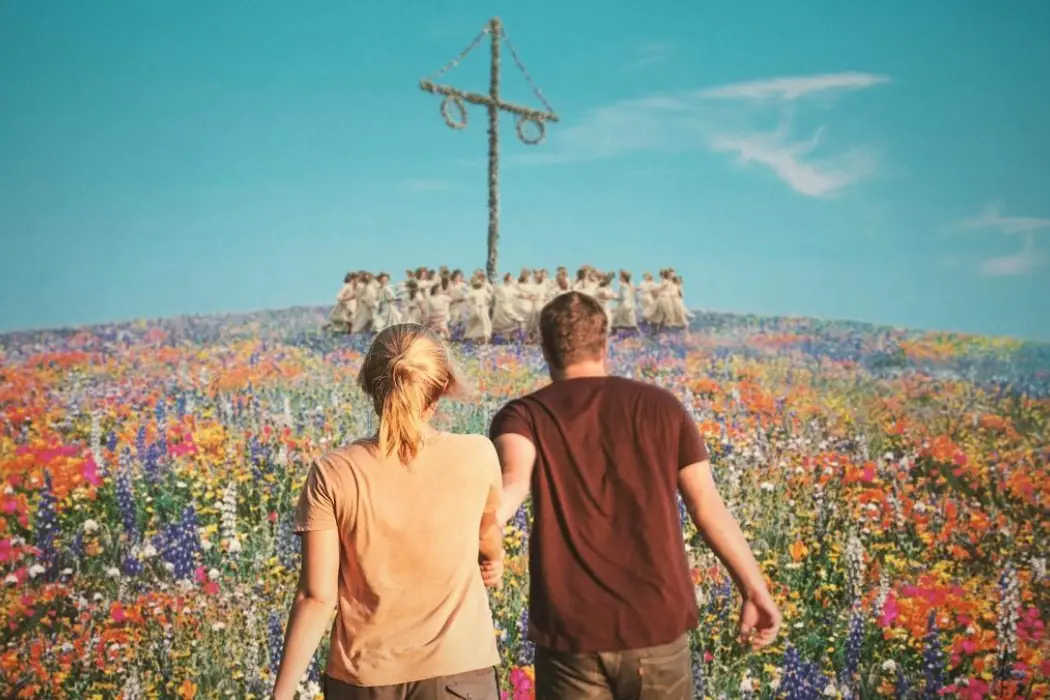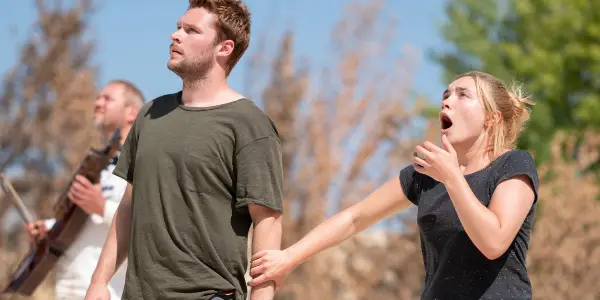MIDSOMMAR: Folk Horror As Folk Art

Caitlin's lifelong love of films began with being shown "Rosemary's…
Midsommar stepped onto the scene to much pomp, circumstance, and with great expectations. The film has some large shoes to fill following the previous Ari Aster entry, Hereditary, and joins the unique and stellar horror subgenre – folk horror. But, none of these expectations really speak to the greatest part of Midsommar.
Midsommar triumphs by virtue of its ability to slowly indoctrinate you into the very cult that you know to fear. Even when the horror is laid out in broad daylight, the film is so seductive that it pulls you in warmly and you only recognize a snare from an embrace when it’s too late. Let the festivities (and this review) begin.
In the film, a couple in turmoil, plagued by their own distance from each other and the personal tragedies of Dani (Florence Pugh), travels to Sweden with their friends to experience the mid-summer festivities of a rural village. What begins as an idyllic retreat quickly devolves into an increasingly violent and bizarre competition at the hands of a pagan cult. Midsommar is written and directed by Ari Aster and is his second feature-length film. The film stars Florence Pugh, Will Poulter, and Jack Reynor.
The Beauty and Baseness of Midsommar
Midsommar is, to put it plainly, a work of cinematic craftsmanship. While some may have their doubts about the two hour and twenty minute runtime, every moment is set up with such intention and even the smallest details are beautifully executed. By very nature, Midsommar is cyclical and the film goes from beginning to end following a cycle of seasons and changes that not only tie into the ritual and belief of our mysterious cult, but speak to the overarching messages on relationships and the all too human experience of life, death, and renewal.
The technical elements of the film are on point. Shots are elegantly composed and speak to the notion that darkness is capable of hiding in broad daylight, but you can spot it if you pay attention. Picture an idyllic country scene, with a corpse appearing in plain sight. Imagine blood staining ancient runes. Unspeakable evil dressed in pastels and flowers.
The film subverts our expectation of what a horror film feels like and that makes every act of violence all the more shocking. A gory kill is impactful enough but hits a whole new level when delivered in plain, vibrant view. Speaking of kills: they’re damn good.

For all of its polish and intentional structure, what makes the film so impactful is that it’s a deeply visceral experience. Everything about the film appeals to something raw and primitive. A natural extension of this earthy approach, common to the folk horror subgenre, are especially brutal kills and rituals. It’s shocking and brings the horror up from deep within your belly.
It’s a delightful dissonance between beauty and baseness. At multiple points in the film, a haunting voice or a chorus of flutes playing the devil’s chord (seriously, there’s some great tri-tone action in the scoring for you music theory enthusiasts) remind us that the peace and contentment of the dreamlike village rests on a foundation of ancient evil.
It’s much easier to speak on Midsommar in terms of its design and themes, but none of that would be possible without the performances of its cast. Rock solid performances all around but I must single out two: Florence Pugh in her role as Dani and Will Poulter as comic-relief-but-so-much-more Mark.
Will Poulter brings a much needed levity to the script, playing your typical “ugly American tourist” that is uninterested in appreciating the culture he has been introduced to. Oddly, Poulter’s performance is more than just solid timing and charming (in a love to hate kind of way) delivery. The character has surprising prophetic depth and it’s a dynamic performance. Well done.
Florence Pugh. My girl. What an absolutely devastating performance! In her role as Dani, Pugh herself becomes a thesis for the whole of Midsommar. Beautiful and warm, but concealing and, in some cases, swallowing all the trauma and hurt.
It’s enchanting to watch her slowly come to embody her surroundings in an incredibly raw and nuanced performance. Absolutely stunning and definitely a career to watch closely, if you haven’t been following Florence Pugh already.
Horror Runs in the Family… the Maternal Side
It’s difficult to talk about Midsommar without drawing some perspective from its predecessor, Hereditary. What we learn from comparing the two is that Ari Aster has a really solid grip on what I’ll call “internal horror.” That is, the study and execution of mental traumas as being as horrific as any kind of external force or harm
The theme of family relations carries across the two films, although the film takes a more broad and universal approach to the concept. It is interesting though, to see Aster’s connection of family trauma and struggle to these ancient occult concepts. Perhaps, the crux of his body of work so far is this meditation on cracks that run deep and threaten to break us apart?

Truly, Ari Aster has proven that he can write one hell of a female lead. If Hereditary was a film about motherhood as it connects to monstrous manifestations of the female experience, then Midsommar goes even deeper and highlights womanhood itself as primitive and monstrous. Let me tell you, I could write a whole other piece on the way gender is at play here.
I wonder what we are to make of the fact that a great deal of the film came about while the writer/director was experiencing the end of a romantic relationship? Be afraid lovers in strife, be very afraid!
The film also draws broad influence from historical and current cultural tradition and festivity, married to a rigorous study of different mythologies and anthropological studies. Ari Aster, as both the director and passionate researcher, was a combination introduced in Hereditary and he has only made that more pronounced. Think of it as going from the capstone class to the graduate dissertation.
Midsommar: The Thematic Tapestry
One of the most striking style elements of Midsommer is its use of illustration, in the form of runes and in the illustrated history that is shown via cultural textiles and folk art in this rural village. Take a moment to Google the Bayeux Tapestry from Normandy, to give you an idea of the intricacy and folk history. There’s a great deal of storytelling that is subtly (and sometimes not so subtly) being carried by this element and it’s a really nice way of leaning into the folk horror subgenre.
It also is an excellent visual thesis statement for how laden in themes and rich discussion Midsommar turns out to be. I very readily compare the film to a tapestry because it is a carefully crafted work, constructed out of many interwoven threads. They tie off and loop around and occasionally meet and you are left with a rich and whole picture. Suffice to say there is a lot going on in the themes of Midsommar.
Ari Aster characterized the film as being a story about empathy, more importantly he specified that the language of this occult community was empathy. This is certainly a focal point of the film and perhaps one of the most interesting in its exeuction. Of course, it comes as no surprise that punishing a lack of empathy is a driving force behind the brutal killing of the outsiders. But what about the intersection of empathy, violence, and mercy?

Pain, violence, and bloodshed live at the heart of this rural community. It is accepted and carried out in the cycle of this culture and its people. Yet, it is also true that every time a village member feels pain (or intense pleasure) it is a communal affair.
When one screams, the whole village screams. It’s a rite in and of itself to take on this performative empathy, sharing fully in experiences that seem as though they’d belong solely to the individual.
The thread of empathy is very closely bound to the second cornerstone of Midsommar: family. The family goes beyond next of kin. It’s a tribe that can be chosen, that you give of yourself fully too, and, most importantly, it is categorized as a desperate need.
To the character of Dani and to the members of the cult, family is desperately sought and relied upon. Of course, the cult takes that quite a few steps farther with ritualized incest. This all flows beautifully into the secondary discussions of toxic codependency and mental health.
Conclusion: Midsommar
As I mentioned at the outset, Midsommar is cyclical in both narrative and structure. The entire film is viewed through this lens of death and renewal, winter turning to summer, and the passing of time and generations. To go into further detail would only spoil the best parts of the film, but the film very elegantly illustrates this cycle both in the occult practices of the village and through the beautiful emphasis on flexibility and nature. At times, the film has a literal pulse to it, that we observe and understand as proof of the connectivity and inevitability of what we are watching. It draws you in and it’s, frankly, damn good.
Midsommar, much like the festival at the center of the plot, is a rare experience that is not to be missed. I can’t necessarily say that I recommend it, as I believe that it is a film that is not enjoyed so much as processed. That being said, you absolutely cannot skip it.
Do you think Midsommar and Hereditary are connected? Let us know in the comments below!
Watch Midsommar
Does content like this matter to you?
Become a Member and support film journalism. Unlock access to all of Film Inquiry`s great articles. Join a community of like-minded readers who are passionate about cinema - get access to our private members Network, give back to independent filmmakers, and more.
Caitlin's lifelong love of films began with being shown "Rosemary's Baby" at way too young an age. She has been an online content creator since 2014, across a wide array of outlets and subjects. Described as "amazingly and beautifully ruthless," Caitlin resides in Austin, TX and her love of writing on film is only matched by her appreciation for good bourbon and the works of John Carpenter.













